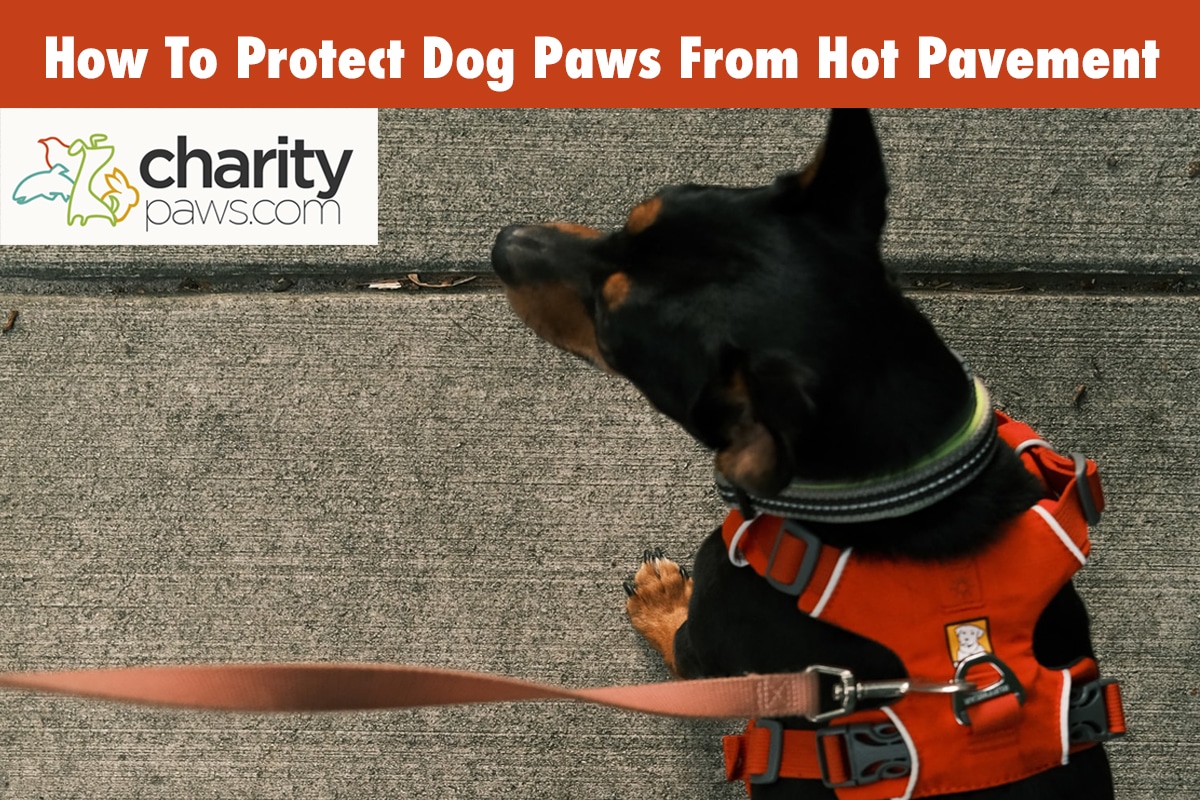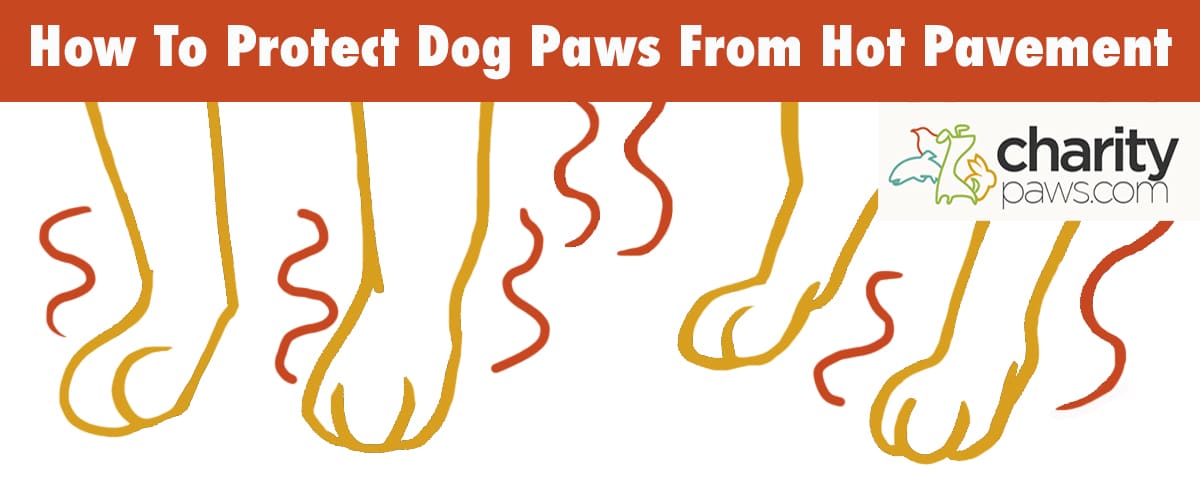With the warm summer months approaching, many unsuspecting pups will suffer from paw pad injuries due to hot asphalt.
Many fur parents are unaware of just how hot pavement can get, leading to painful burns for our canine friends.
Dog owners should not only be aware of this common heat related injury, but how they can best protect their pup during their daily walks.
In this article we will discuss the easiest ways to measure pavement heat, how you can best protect your dog’s paws, and how to care for their paws if a burn does occur.

How Hot Can Pavement Get?
Many people assume that the temperature of the pavement is similar to the temperature outside, but this is not true at all.
The asphalt can get shockingly hot even when temperatures are not scorching, as the pavement can be almost double the temperature.
If a section of the pavement is in the sun on a 70-degree day, the surface can get hot enough to burn a dog’s paws.
Even 60 seconds is enough time to cause a severe paw burn, which is why it is so important to test the pavement before walking your pup.
How Do I Know If Pavement Is Too Hot For My Dog’s Paws?
If you are unsure whether or not the pavement is safe for your pup to walk on, there is an easy way to check!
Just place the back of your hand on a portion of the cement that is in the sun, and hold it there for 7-8 seconds.
If it is too hot to do this comfortably, it is too hot for your dog’s paws.
Another way to estimate the temperature of the pavement is by having an understanding of how much hotter the pavement can be than the outside temperature.
Pavement can be anywhere from 40-60 degrees higher than the outside temperature, especially if the pavement is in direct sun without wind.
To help you better estimate how hot the asphalt could be, here’s a chart that breaks down the details.
| Outside Temperature | Pavement Temperature |
| 75 degrees F | 120 degrees F |
| 85 degrees F | 130 degrees F |
| 90 degrees F | 150 degrees F |
Destruction of the paw pad can begin at 125 degrees Fahrenheit within 60 seconds, so even a warm spring day can lead to paw pad injuries.
How To Protect Dog Paws From Hot Pavement
Now that you are aware of how hot the pavement can be, you can understand why paw pad burns are such a common occurrence in the hot summer months.
Many dog owners usually have no idea that their pups paws are burnt.
You may have never thought of this as being an issue until now.
If you and your pup go on frequent adventures around the town, it’s important to be aware of the best ways to protect their paws from the hot pavement.
Have Your Dog Stay On The Grass
While the pavement may reach scorching levels on a hot day, the grass will not.
Walking on the grass can help your pup avoid painful paw pad burns, while still allowing them to participate in outdoor adventures.
If you are able to avoid the pavement and stick to grassy areas, this is perfectly safe.
Walk Your Dog During Cool Hours (Early Mornings, After Sunset)
If there is no way to avoid pavement on your daily walks, just be sure to walk your dog in the early morning hours or late evening, as the pavement will be nice and cool by this point.
The hours between 6am-10am are typically safe in the morning, while the hours of 6pm to 9pm are best for evening walks.
Strengthen Their Paws
While hot pavement will still burn even the toughest of paws on a warm day, strengthening your dog’s paws can offer them some protection.
You can do this by walking them on pavement as often as possible when the temperature is cool, as this will cause the tissue on their paw pad to thicken.
Doing this can provide a natural barrier to many things a dog can encounter, even a brief encounter with burning pavement.
Keep Their Paws Moisturized
The more hydrated your dog’s paws are, the less likely they are to crack and peel throughout their walks.
A cracked paw is more at risk of serious burns and injuries, as the tissue exposed is much more sensitive.
The best way to understand this is by picturing a blister on our hand, and how much more sensitive this area is when performing daily tasks.
Use Dog Shoes When It’s Hot
If there is no way for your active pup to avoid the hot pavement, dog shoes and booties can be a wonderful way to offer them protection.
These shoes strap onto their paws and provide a thick barrier between their paw pad and the cement, allowing them to spend as much time as they would like on the hot asphalt.
These shoes can also be beneficial for dogs that go on hikes, as they can protect against paw pad injuries from rough terrain as well.
Symptoms Of Pavement Burns In Dogs
No matter how many precautions we take when walking our pups in the hot summer months, accidents can still happen.
Some dogs can receive paw pad burns within seconds of touching the cement, especially if they are waking during the hottest time of the day.
To help you spot paw pad burns in your dog, let’s list some of the symptoms to be on the lookout for.
Some of the most common symptoms of paw pad burns include:
- Limping
- Refusal to walk around
- Frequent licking of the paws
- Cracking of the paws
- Peeling skin on the paws
- Patches of red, irritated tissue on the paw pads
- Swelling of the paws or tissue around the paws
- Paw pads are darker than usual
- Blisters on the paw pad
- Odor from the paws
- Smears of blood found on the floor of your home
If you notice any of the above symptoms in your dog, they may have sustained a paw pad injury on their walk.
First Aid For Burnt Dog Paws
So what should you do when your dog burns their paws on a walk?
Though we always suggest having them seen by a veterinarian to prevent infections, there are a few first aid tips that you can apply at home first.
First, we suggest ending your walk and bringing them inside as soon as possible.
Many dogs will begin to limp if they have injured their paw pads, so this will be your sign that it’s time to call it a day and come back home.
Once you come back inside, you can then rinse their paws with cool water to remove any dirt, as well as soothe the area if they are in pain.
Some pups will not allow you to do this if they are in significant pain, so you can skip this step and bring them directly to your vet’s office.
Once you put an end to your walk and rinse the paw pads, we suggest giving your vet a call.
You can then explain the appearance of your dog’s paws over the phone, allowing your vet to determine whether or not your dog should be seen as soon as possible.
Some vets may recommend having them seen regardless, but a simple phone call is always best just in case.
If the paws look perfectly normal, your vet may suggest simply monitoring your dog at home and keeping them as calm as possible.
However, if your dog’s paw pads have any obvious injuries, your vet will recommend bringing them in for an exam.
Treating Paw Pad Burns In Dogs
The standard treatment for paw pad burns in dogs will vary based on the severity of the burns.
Their treatment can involve anything from daily foot soaks to antibiotics and rest, so we always suggest trusting your vet’s guidance based on their case.
No matter how severe their burns are, you will always need to prevent them from licking their paws, as well as implementing strict cage rest until the paws heal.
While these aspects of treatment are simple, they are the most important tools in preventing infection and promoting recovery.

Final Thoughts On Dog Paws And Hot Pavement
Paw pad burns are a common, yet preventable injury seen in many furry friends during the summer months.
As long as you implement the tips we discussed above on paw pad protection, you can keep their paws safe during your outdoor adventures.
The most common way to keep your dog’s paws from burning is by using dog shoes or socks, as these will keep a barrier between their paws and the hot pavement.

